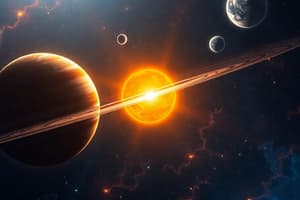Podcast
Questions and Answers
What is the name given to large areas of land on Earth?
What is the name given to large areas of land on Earth?
- Continents (correct)
- Forests
- Islands
- Wetlands
Which component does the hydrosphere consist of?
Which component does the hydrosphere consist of?
- Air and gases
- Oceans and rivers (correct)
- Plant life and bacteria
- Solid landforms
What are the primary gases that make up the atmosphere?
What are the primary gases that make up the atmosphere?
- Nitrogen and Oxygen (correct)
- Neon and Ozone
- Oxygen and Helium
- Hydrogen and Carbon Dioxide
What role does the biosphere play in relation to living organisms?
What role does the biosphere play in relation to living organisms?
How much of the Earth's surface is covered by land?
How much of the Earth's surface is covered by land?
What is the closest planet to Earth?
What is the closest planet to Earth?
Which of the following statements about Earth is true?
Which of the following statements about Earth is true?
Which sphere of the Earth is described as the solid surface?
Which sphere of the Earth is described as the solid surface?
What distance is considered the closest point between Earth and the Sun?
What distance is considered the closest point between Earth and the Sun?
Why is the Earth able to support life?
Why is the Earth able to support life?
What is the farthest distance between Earth and the Sun?
What is the farthest distance between Earth and the Sun?
What roles do satellites serve in the Solar System?
What roles do satellites serve in the Solar System?
Which of these is not considered a part of the Earth’s spheres?
Which of these is not considered a part of the Earth’s spheres?
Flashcards are hidden until you start studying
Study Notes
The Solar System
- Composed of the Sun and smaller bodies that rotate on their axis and revolve around the Sun
- Includes planets like Mercury, Venus, Earth, Mars, Jupiter, Saturn, Uranus, Neptune, and satellites
- Pluto is no longer considered a planet as it is far from the Sun, small, and not visible
- Satellites are small bodies like planets rotating on their axis and revolving around larger planets
- The Moon is Earth's satellite
- Planets and satellites are held in place by the Sun's gravitational force
- Mercury is the closest planet to the Sun, while Neptune is the farthest
- Venus is the closest planet to Earth and is the brightest object in the night sky after the Moon
- Venus appears after sunset from March to October in the western sky and before sunrise from November to December in the eastern sky
The Earth
- The third planet from the Sun
- The fifth largest planet in terms of size
- The closest distance between Earth and the Sun is 147 million kilometers, observed in January
- The farthest distance is about 152 million kilometers away from the Sun, observed in July
- The only planet known to support life due to the presence of air and water
Spheres of the Earth
- Lithosphere: The outermost layer of the Earth, a solid surface composed of hills, mountains, continents, and islands
- Hydrosphere: The portion of Earth covered by water, including oceans, seas, lakes, rivers, streams, and ponds
- Atmosphere: The layer of air surrounding the Earth's surface, composed of gases, dust particles, and water vapor
- Contains 78% nitrogen, 21% oxygen, and the remaining 1% consists of carbon dioxide, hydrogen, helium, ozone, and neon
- Extends up to 1600 kilometers from the Earth's surface
- Biosphere: The region of Earth that encompasses all living organisms, such as plants, animals, and bacteria
- Plays a crucial role in recycling nutrients like oxygen and nitrogen to sustain life on Earth
- Provides food and raw materials for all living organisms
Key Facts
- Approximately 30% of the Earth's surface is covered by land
- Approximately 70% of the Earth's surface is covered by water
Studying That Suits You
Use AI to generate personalized quizzes and flashcards to suit your learning preferences.




